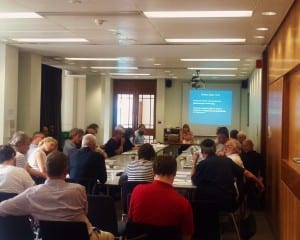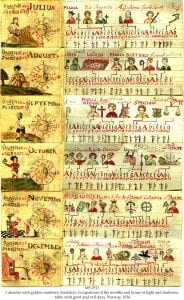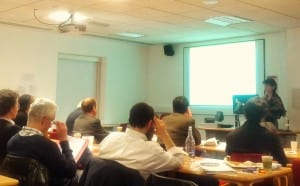Our 5th Workshop, ‘The origins of the seven-day week’, took place on the 25th of June 2015. With it, we inaugurated a new format of very focussed workshops, which are meant to address, in turn, individual research interests of each member of our multidisciplinary team. The first workshop of this new series dealt with the theme investigated by this post’s writer. The seven-day week stems from two distinct traditions: the Biblical week of the Sabbath, and the astrological, planetary week. The main purpose of this workshop was to explore how these two traditions emerged and spread in the Roman Empire, and how they combined remarkably into a single, seven-day unit of time reckoning that was to become standard in the medieval and modern worlds.
We arranged the workshop programme into three thematic sessions: ‘The planetary week’, ‘The Jewish seven-day week’, and ‘The seven-day week in the Roman Empire’.

After a brief general introduction by Sacha Stern (UCL), Wolfgang Hübner (Münster) opened the first session with a paper entitled ‘When and where was the planetary week invented?’. An examination of the (rather scanty) relevant sources led him to confirm the general assumption that the so-called system of the chronocrators – according to which the seven ‘planets’ rule in succession the hours and days of the week – underlies the planetary week cycle. This system is based on the ‘Chaldean order’ of the planetary spheres, which would thus appear to lead back to ancient Babylonia, the birthplace of astrology; nonetheless, there are no traces of this order before the 2nd century BCE, when astral sciences were much developed, not in Babylonia, however, but in the Hellenised Egypt of the Ptolemies. Further hints pointing to an origin of the planetary week in Hellenistic Egypt are not lacking; on these bases, Hübner proposed that this weekly system was created during the 3rd or 2nd century BCE in Alexandria. Béatrice Bakhouche (Montpellier) spoke about ‘Evidence of the planetary week in Rome: issues and debates’. By reconsidering part of the evidence that had already been examined in the previous talk, as well as the most significant Roman sources related to the adoption and use of the planetary week in the Roman west, she emphasised how the Romans were strongly influenced by astrological and Pythagorean ideas towards the end of the Republican period. This may have played a role in the Roman adoption of the planetary week, which, however, had initially a strictly astrological use, before evolving into a real calendrical tool. Given the limited number of sources attesting to the existence and use of this type of week in the early imperial period, she argued that the planetary week was not officially used in the Roman west earlier than the late 2nd – early 3rd century CE. In addition, she contributed to the question of the origins of the planetary week by stressing how a Jewish influence on the Roman calendar can hardly be assumed, considering the Romans’ general view of the Jews, which was mainly linked to an idea of marginality. Ronit Yoeli-Tlalim (Goldsmiths) offered a glimpse into a different historical and geographical context with her talk on ‘Notes on the Tibetan planetary week and its possible sources’. She pointed out that the planetary week presumably arrived to Tibet through India and, in turn, it was the Hellenic culture that transmitted this knowledge to India. Indeed, contacts and relations between Greeks and Indians go back to as early as the Hellenistic period, since the Indian campaign that Alexander the Great started a few years before his death. Unfortunately the times and modes of this transmission are not known; it is however attractive to imagine that the astrological notion of the planetary week spread towards India from Ptolemaic Egypt during the late Hellenistic period. We would thus have a further confirmation for the assumption that the planetary week originated in the Hellenised Egypt of the Ptolemies.
In the second session of our workshop, François de Blois (UCL) discussed ‘The etymology of Sabbath’. The Hebrew name for the seventh day has usually been connected with the verbal root š‑b‑t “to rest”, assuming either a denominal verb or a deverbal noun. Both of these options are, however, linguistically problematic. An alternative suggestion has been to connect it with Babylonian šapattu (or šabattu), which designates the 15th day of the lunar month, the full moon, or a group of 15 days. This is phonologically relatively unproblematic, but it is difficult from a semantic point of view. The paper attempted to problematize this situation and offered some tentative solutions. Jonathan Ben-Dov (Haifa) enlightened us about ‘The early history of the Jewish week’. Despite the great antiquity of the Biblical seven-day week, the weekly cycle was not used as a principle for constructing the calendar in the Bible, nor is there any trace of days of the seven-day week in priestly literature. A change occurs in the Book of Jubilees, which dates to the mid-2nd century BCE, and, slightly later, in the Qumran texts. The value of these sources as evidence that the week was used for practical purposes, however, is not certain. Days of the week are still absent from date formulae in the same period, and will make their first appearance, on ostraca, only in the 1st century CE. Ben-Dov’s assumption is that the Jews started using days of the week for practical purposes in the 1st century BCE; however, there are no traces of any connection of the Jewish week with the planetary week, which seemingly first appeared around the same period in the western Roman world.

My own contribution, together with that of Sacha Stern, made up the third and last session of the workshop. In my paper ‘The diversity and spread of the seven-day week in the Roman Empire’, I presented the results of the full database of literary, epigraphic, and documentary sources in Greek and Latin either including days of the week or dealing with the week, which I have been creating in approximately the last two years. I first focussed on the origins, earliest attestations, and diffusion of the planetary week in the Roman Empire, as well as on the contexts and uses of this dating system. My assumption is that although an actual calendrical use developed quite early, the planetary week first spread in the Roman west as an astrological concept, which most likely originated in Ptolemaic Egypt during the late Hellenistic period. During the imperial period the early Christians adopted the Jewish week with its six days denoted by numbers and the Sabbath as its seventh, and adapted it to their religion by dedicating the first day of the week – Sunday, the Lord’s Day – to their own God. However, the evidence shows that the Christian week did not gain much popularity, at least in the Roman west, where, despite reiterated attempts by the Church Fathers and preachers to eradicate the habit, common people, including Christians, largely continued to name the days of the week after the seven planets in late antiquity, due to the longer tradition of the planetary week in this area of the Roman Empire. Sacha Stern (UCL) discussed ‘The seven-day count in the Roman Empire: standardization and fixation.’ The main goal of this paper was to assess how standard was the reckoning of the seven-day week, i.e., to what extent, e.g., Sunday was the same day for everyone, from Ptolemaic Egypt to late Antiquity. Our database of ancient sources allowed him to carry out a statistical study, according to which in late antiquity – the period for which we have an adequate sample of certainly dated sources – the day of the week was overwhelmingly standard and in phase with ours. The study also confirmed the standard equation of planetary and Jewish/Christian days (e.g. day of Saturn = Sabbath). In the second part of his talk, he focussed on evidence covering the Ptolemaic and early Roman periods. He first showed the results of a similar, statistical study that he conducted on the material included in the Corpus Papyrorum Judaicarum, which comprises securely dated papyri, ostraca, and inscriptions from Hellenistic and Roman Egypt, written by, for, or about Jews. The working hypothesis is that Jews did not work on the Sabbath, including legal work, commerce, and financial transactions, and therefore that most documents (contracts, receipts, etc.) should not have been written on the Sabbath. On this basis, it should be possible to verify whether or not this day was in phase with the standard week. According to this study, in these early periods the week was not standard and in phase with ours. A similar result emerged from an analogous study of a dossier of receipts for the payment of the ‘Jewish Tax’ from Edfu, in Upper Egypt. This is a special tax that the Emperor Vespasian imposed on the Jews in the Roman Empire after the destruction of Jerusalem and its Temple in 70 CE. A dated graffito from Pompeii from this same period, along with the sole dated document from the Ptolemaic period included in our database, further confirmed this result, and led to the concluding conjecture that the Sabbath in Ptolemaic Egypt corresponded to what is for us Tuesday or Wednesday.
This workshop was particularly well attended, and well received by the participants. Both members of our team and external attendees generally agreed on its highly instructive value, which applied to experts on the very specific topic of the workshop and ‘neophytes’ alike.
 Close
Close











